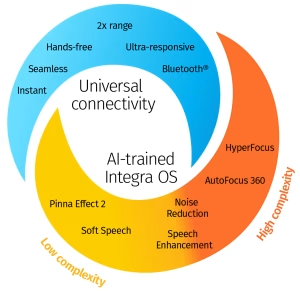

Have you ever noticed that when you plug your ears, the world around you suddenly feels different? Not only does the ambient noise become muffled, but there’s also a peculiar sensation of occlusion – as if you’ve entered a soundproof bubble. Strangely enough, this occlusion doesn’t just affect your ability to hear; it also has a curious impact on your perception of how loudly you’re speaking. Let’s dive into the fascinating world of ear physiology and psychology to uncover the reasons behind this peculiar phenomenon.
The term “occluded ear canal” refers to a condition where the ear canal is partially or completely blocked or obstructed, hindering the normal flow of air and sound waves into the ear. This obstruction can occur due to various factors, including the use of earplugs, earwax buildup, foreign objects in the ear, or the insertion of hearing aids or earphones.
When the ear canal is occluded, it can lead to several perceptual changes in how sounds are heard and processed. One notable effect is the occlusion effect, where low-frequency sounds are trapped within the sealed ear canal, resulting in a feeling of fullness or hollowness. This phenomenon is often experienced when using hearing aids or earplugs that block the ear canal.
In a medical context, an occluded ear canal may be a result of conditions such as earwax impaction, ear infections, or the presence of a foreign body. It’s important to address any occlusion of the ear canal promptly, as it can impact hearing, cause discomfort, and potentially lead to more serious issues if left untreated. If you suspect an occlusion of your ear canal or experience changes in your hearing, it is recommended to seek guidance from a healthcare professional or an audiologist for an accurate diagnosis and appropriate intervention.
To understand why plugging your ears leads to a sense of occlusion, it’s essential to grasp the basics of ear anatomy. The ear is a complex organ divided into three main parts: the outer ear, the middle ear, and the inner ear. When you plug your ears, you disrupt the normal transmission of sound waves into the ear canal, altering the way you perceive external sounds.
The outer ear captures sound waves and directs them into the ear canal, where they reach the eardrum in the middle ear. This vibration is then transmitted to the tiny bones in the middle ear, which, in turn, transmit the signals to the cochlea in the inner ear. When you insert earplugs, this process is interrupted, causing a reduction in the intensity and clarity of external sounds.
Now, let’s explore the connection between occlusion and the way we perceive our own voices. When you speak, sound waves travel not only through the air but also internally through the bones and tissues of your head. This dual pathway allows you to perceive your voice in two ways: through air-conducted sound and bone-conducted sound.
When you plug your ears, the external sound is significantly reduced, affecting the air-conducted component of your voice perception. Without the usual feedback from the external environment, your brain relies more on the bone-conducted component, which is not as affected by earplugs. This shift in reliance creates a dissonance between how you perceive your voice internally and how it actually sounds to others in the external environment.
The mystery deepens when we consider why people often speak louder than they intend when their ears are plugged. The phenomenon can be attributed to the lack of external auditory feedback, which plays a crucial role in regulating speech volume. When you can’t hear your own voice as clearly, there’s a natural tendency to overcompensate by speaking louder.
Additionally, the occlusion effect may create a psychological illusion of being isolated from the surrounding environment, leading to a false perception that others can’t hear you well. This misconception can prompt individuals to unintentionally raise their voice levels, contributing to the paradoxical experience of feeling occluded yet speaking louder than necessary.
For those who use hearing aids, the occlusion effect is a common phenomenon that can impact their overall auditory experience. The occlusion effect occurs as we learned above, when the ear canal is partially or fully blocked by a hearing aid, leading to a feeling of “hollowness” or “muffling” in the wearer’s own voice and other sounds. This blog aims to shed light on the occlusion effect in hearing aids, its causes, and potential solutions to enhance the comfort and effectiveness of hearing aid use.
The occlusion effect arises when the ear canal is blocked, causing low-frequency sounds to be trapped and reverberate in the ear. This trapped sound creates a perception of increased loudness and resonance, affecting both the wearer’s own voice and the sounds from the surrounding environment. The sensation is often described as a feeling of being underwater or in an enclosed space.
· Sealed Ear Canal: In-canal or completely-in-the-canal hearing aids, which fit snugly into the ear canal, are more likely to cause the occlusion effect due to the sealing of the ear canal.
· Low-Frequency Sounds: The occlusion effect is more pronounced with low-frequency sounds, as they are more likely to be trapped and amplified in the sealed ear canal.
· Ventilation Issues: If the hearing aid lacks proper ventilation or has a too-small vent, it can contribute to the occlusion effect.
Open-fit hearing aids are designed to leave the ear canal open, reducing the occlusion effect. They allow natural sounds to enter the ear canal, providing a more comfortable listening experience.
Ensuring proper ventilation in the hearing aid design, such as using vented ear molds, helps alleviate the occlusion effect by allowing some sound to escape the ear canal.
Advanced digital signal processing technology in modern hearing aids can minimize the occlusion effect by adjusting amplification levels for specific frequencies, reducing the perception of trapped sound.
Keeping hearing aids clean and well-maintained is essential. Earwax buildup can exacerbate the occlusion effect, so regular cleaning and check-ups with an audiologist are crucial.
Seeking guidance from an audiologist is invaluable for adjusting to hearing aids and overcoming challenges like the perception of one’s voice being too loud and the occlusion effect. Audiologists are trained professionals who specialize in assessing and addressing hearing-related issues. They can provide personalized adjustments to the settings of your hearing aids, ensuring that the amplification aligns with your unique hearing needs. Additionally, audiologists offer insights into managing the occlusion effect, a common concern when using hearing aids. Through their expertise, they can guide you on selecting the right type of ear tips or domes, adjusting ventilation, and providing strategies to minimize the feeling of being plugged. The support of an audiologist goes beyond technical adjustments; they play a crucial role in helping individuals adapt to their hearing aids, optimizing comfort, and enhancing the overall effectiveness of the devices in various listening environments.
Over-the-Counter (OTC) hearing products, including personal sound amplification products (PSAPs) and some basic hearing aids, often come with standard domes or ear tips that may cause an occlusion effect – a sensation of being plugged or muffled due to the sealed ear canal. Overcoming this issue is essential for users to have a comfortable and effective listening experience. Here are some common strategies to address the occlusion effect caused by standard domes:
· Look for OTC hearing devices with open-fit designs. Open-fit devices typically have ear tips or domes that do not completely seal the ear canal, allowing some natural sound to enter.
· Consider products with built-in vents or air channels in the earpieces. These features facilitate airflow and reduce the sensation of occlusion.
· Explore OTC hearing devices that come with different sizes of ear tips or domes. Having a variety of sizes allows users to find the most comfortable fit that minimizes the occlusion effect.
· Some products provide memory foam or silicone ear tips that conform to the shape of the ear canal, enhancing comfort and reducing the sensation of being plugged.
· Experiment with the positioning of the ear tips or domes. Sometimes a slight adjustment in how the device sits in the ear can alleviate the occlusion effect.
· Check if the device allows for angle adjustments. Tilting the earpiece slightly can impact the perception of occlusion.
· Ensure that the ear tips or domes are clean and free from earwax or debris. Earwax buildup can exacerbate the occlusion effect.
· Clean the hearing device regularly following the manufacturer’s guidelines to maintain optimal performance.
When purchasing OTC hearing products, inquire about the availability of trial periods or return policies. This allows users to test the device in real-life situations and return it if the occlusion effect is a persistent issue.
If the occlusion effect persists, consider consulting with a hearing care professional or audiologist. They can provide personalized advice and may recommend adjustments or alternative solutions based on your specific needs.
It’s important to note that while OTC hearing products can be a convenient and accessible option, they may not suit everyone’s hearing needs. Individuals with more complex hearing requirements or persistent issues may benefit from a comprehensive hearing evaluation by a licensed audiologist, who can recommend and fit hearing aids tailored to their unique hearing profile. You don’t have to walk around feeling like you are plugged, can’t hear any better and your voice echos.
We have choices at Hears Hearing & Hearables. Tell us what you have experienced in the past and we can help make suggestions, offer different domes or even refer you to a professional that can help near you.
Powered By SinglerDesign.com